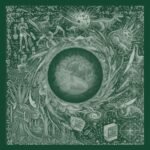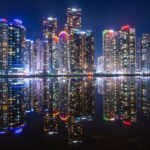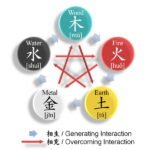 |
Gyeongju, the ancient capital of the Silla Kingdom, is a city often called a “museum without walls” because of its incredible historical significance. It served as the capital for nearly a thousand years (57 BC – 935 AD), and as a result, the entire city is filled with historical treasures. Many of its attractions, including Buddhist temples, royal tombs, and traditional villages, are recognized as UNESCO World Heritage Sites. • Key Historical Sites • 📍Bulguksa Temple: This temple is a prime example of the pinnacle of Buddhist art during the Silla Kingdom. Its architecture symbolizes the journey to enlightenment, with various pavilions and staircases representing the ascent from the earthly to the celestial world. It houses important national treasures, such as the Dabotap and Seokgatap stone pagodas, both dating back to the 8th century. 📍Seokguram Grotto: Located on the peak of Mount Tohamsan, this artificial granite grotto houses a breathtaking monumental statue of a seated Buddha looking out toward the sea. The grotto and its architectural complex are considered a masterpiece of Far Eastern Buddhist art. Its design symbolizes the spiritual journey, with the antechamber representing the earth and the rotunda the heavens. 📍Daereungwon Royal Tombs: In the heart of Gyeongju, Daereungwon Park is a collection of large, grass-covered mounds that are actually the tombs of ancient Silla monarchs and nobles. Walking through this park offers a unique journey into the past. One of the tombs, Cheonmachong, is open to the public, allowing visitors to see the inside of these burial complexes and view some of the thousands of luxury items found within, including crowns, swords, and jewelry. Thanks for sharing and for showing interest in this type of content! ST69 🫡 submitted by /u/No_Solution_4438 |
Related Posts
Latest News from Korea
- SK Hynix to ramp up 1c DRAM production 8-fold in 2026SK Hynix’s DRAM plant in Icheon SK Hynix Inc., a crucial supplier of high-bandwidth memory to Nvidia Corp.’s artificial-intelligence processors, is set to boost output of its sixth-generation 10-nanometer DRAM, known as 1c DRAM, by roughly eightfold next year, as the AI industry’s center of gravity moves beyond training and toward large-scale inferencing. According to industry sources on Thursday, the… Read more: SK Hynix to ramp up 1c DRAM production 8-fold in 2026
- Yen’s slide pushes Korean won to a 7-month low amid worries over Japan’s fiscal plan(Courtesy of Yonap) The Korean won fell to its weakest level in seven months on Thursday, weighed down by a sharp decline in the Japanese yen following reports of Japan’s massive spending plan. The won briefly weakened past 1,470 to the dollar in afternoon trade, before closing at 1,467.90, up 2.3 won from the previous day. That marked its weakest… Read more: Yen’s slide pushes Korean won to a 7-month low amid worries over Japan’s fiscal plan
- S.Korea’s NPS gets $7.8 mn in refund after Sweden grants long-sought tax-exempt statusThe National Pension Service is South Korea’s largest institutional investor The National Pension Service (NPS), South Korea’s state-run pension fund and the country’s largest institutional investor, has secured a landmark victory in Sweden, winning recognition that it is exempt from withholding tax on dividends from Swedish listed equities. The decision will return about 11.5 billion won ($7.8 million) to the fund… Read more: S.Korea’s NPS gets $7.8 mn in refund after Sweden grants long-sought tax-exempt status
- Samsung Heavy lands nearly $1.4 bn box-ship deal, boosting sharesOne of container ships built by Samsung Heavy Industries (Courtesy of Samsung Heavy) Samsung Heavy Industries Co., one of South Korea’s top three shipbuilders, has secured a landmark order for seven container carriers worth nearly 2 trillion won ($1.4 billion), giving the yard one of its largest single contracts and sending its shares higher on Thursday. The company said in… Read more: Samsung Heavy lands nearly $1.4 bn box-ship deal, boosting shares
- Samsung Display prevails in OLED patent battle with China’s BOE(Courtesy of Samsung Display) Samsung Display Co., the panel-making arm of Samsung Electronics Co., has won in a years-long patent fight with China’s BOE Technology Group, clearing the way for the South Korean display maker to collect sizable royalty income and reinforce its position in the global organic light-emitting diode (OLED) supply chain. The US International Trade Commission announced on… Read more: Samsung Display prevails in OLED patent battle with China’s BOE
Latest Entertainment from Korea
- Synsnake : NodesIt’s criminal that we had to wait four years for a follow-up to Fluxus. But the fact that in current times, when a band releases a new full length, it feels magical. And that it’s Synsnake is excellent. Nodes is their second full length and continues the band’s metalcore, electronicore, and “k-popcore” sound. If you’re coming to Synsnake without any… Read more: Synsnake : Nodes
- CNBLUE 2026 ‘3LOGY’ World Tour in Oceania: Melbourne, Sydney & Auckland Dates, Band History, Discography and How to Get TicketsPhoto Credits: FNC Entertainment (에프엔씨엔터테인먼트) 2026 ‘3LOGY’ Oceania dates The 2026 CNBLUE LIVE WORLD TOUR ‘3LOGY’ in Oceania brings the band to three key cities: Melbourne, Sydney, and Auckland. According to the official notice, the dates and venues are: Melbourne – Palais Theatre on 12 March 2026 (Thursday), Sydney – Sydney Event Centre on 14 March 2026 (Saturday), and Auckland… Read more: CNBLUE 2026 ‘3LOGY’ World Tour in Oceania: Melbourne, Sydney & Auckland Dates, Band History, Discography and How to Get Tickets
- Chuei Liyu Draws His Own Destiny: Inside W Korea’s November 2025 Pictorial Preview and the Making of a New K-Fashion MusePhoto Credits: W Korea FNC Entertainment There is a particular kind of quiet voltage that only a true rising star carries into a frame, and in W Korea’s November 2025 pictorial preview, Chuei Liyu channels that charge with studied ease. Fresh from survival show fame and already stepping into his own as a solo artist and fashion muse, he appears… Read more: Chuei Liyu Draws His Own Destiny: Inside W Korea’s November 2025 Pictorial Preview and the Making of a New K-Fashion Muse
- Dinosaur Running Club : Long Slow DistanceDinosaur Running Club plays a nostalgic mellow and modern rock style. The four-song EP, Long Slow Distance, takes the band’s “running” motif and combines that with 16 minutes of music. This is a surprising listen because the band throws in a lot of depth on a limited number of tracks. “Sci-Fi…” is like a warm-up and slow jog. Dinosaur Running… Read more: Dinosaur Running Club : Long Slow Distance
- BTS’s Jungkook Ignites Rolling Stone UK’s December 2025 Cover: A Global, High-Fashion Preview of the Next BTS EraPhoto Credits: Rolling Stone UK. BigHit Music Jungkook of BTS is set to front the December 2025 issue of Rolling Stone UK in a high-impact global exclusive, with a teaser cover already sending ARMY into a preorder frenzy. The shoot aligns with BTS’s anticipated 2026 group comeback, positioning Jungkook as both a solo powerhouse and the face of the group’s… Read more: BTS’s Jungkook Ignites Rolling Stone UK’s December 2025 Cover: A Global, High-Fashion Preview of the Next BTS Era
Learn People & History of Korea
- The Evolution of Busan: A Historical Journey Through South Korea’s Second Largest Metropolitan CityAncient Beginnings: The Founding of Busan Busan, known as the second largest metropolitan city in South Korea, has a rich history that dates back to ancient times. The earliest recorded existence of Busan can be traced to the Goryeo Dynasty, where it was referenced as a vital coastal settlement. Its strategic location along the southeastern coast of the Korean Peninsula… Read more: The Evolution of Busan: A Historical Journey Through South Korea’s Second Largest Metropolitan City
- The Evolution of Pyongyang: A Journey Through History, Economy, and Political DynamicsIntroduction to Pyongyang Pyongyang, the capital city of North Korea, serves as a prominent symbol of the nation’s history and culture. Geographically located on the banks of the Taedong River, in the southwest part of the country, Pyongyang is situated within a strategic area that has historically facilitated trade and cultural exchange. The city’s origins can be traced back to… Read more: The Evolution of Pyongyang: A Journey Through History, Economy, and Political Dynamics
- The Evolution of Seoul: From Ancient Korea to Modern Metropolis and BeyondAncient Beginnings: The Founding of Seoul The city of Seoul, known today as the vibrant capital of South Korea, has ancient roots that trace back to the Three Kingdoms period of Korea, specifically the kingdoms of Baekje and Silla. Evidence suggests that Seoul was originally established as a settlement given its strategic geographical advantages. Nestled within the Han River basin,… Read more: The Evolution of Seoul: From Ancient Korea to Modern Metropolis and Beyond
- Exploring Korean Traditional Games in Squid Game: From Season 2 to Upcoming Season 3Introduction to Korean Traditional Games Korean traditional games have long been an integral part of the country’s cultural landscape, offering more than mere entertainment. These games, which range from simple children’s pastimes to complex community activities, hold significant cultural significance and often serve as a means of preserving history and promoting social interaction. Rooted in centuries of tradition, these games… Read more: Exploring Korean Traditional Games in Squid Game: From Season 2 to Upcoming Season 3
- Unveiling the Past and Present of Saju: The Art of Korean Fortune TellingIntroduction to Saju Saju, a traditional Korean fortune-telling practice, is an intricate art that seeks to interpret an individual’s fate based on their birth date and time. The term “Saju” translates to “four pillars” in English, referring to the four critical components derived from these time markers: year, month, day, and hour. This method holds significant cultural value within South… Read more: Unveiling the Past and Present of Saju: The Art of Korean Fortune Telling















